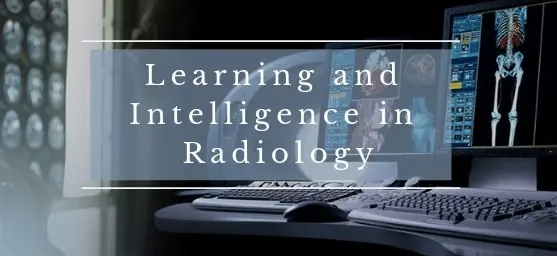Learning and Intelligence in Radiology

I recently attended an interesting lecture hosted by the New India Foundation on the subject of How to Fix Primary Education in India, by an eminent speaker from the Massachusetts Institute of Technology, Prof Esther Duflo, in which she elegantly described, using randomized controlled trial data generated by her organization’s field research, what is erring in our school level education system in India. The talk in itself was illuminating and the subsequent Q and A conversations over dinner added additional perspectives. In particular, a conversation I had with Mrs. Rohini Nilekani, the wife of the founding trustee and herself a committed social philanthropist in the field of education, made me think about the whole teaching-learning paradigm. She mentioned that her children had returned from their education in the US far more confident and articulate than when they left. In turn I shared with her my own experience of having trained as a radiologist both in India and in the US, which is that in India we are taught how to learn, whereas in the US we are taught how to think, which she agreed resonated with her own observations.
Fundamentally, the difference between the British education method which we follow in India is the ability to digest and retain vast amounts of information which is actually an advantage in careers such as medicine where there are massive amounts of data to be absorbed over a relatively short period of time. The popularity of memory improvement methods and the proliferation in the number of preparation courses for competitive exams at all levels are evidence of this if any was needed. This also possibly accounts for the fact that Indian medical graduates perform well on the exams that one needs to take to travel overseas, having an encyclopedic knowledge of their subject, often superior to their western counterparts.
Where the US academic system excels though is in its ability to engage and challenge the mind of the student (essentially teaching how to think). By repeating the process of solving a problem, typically in an on-ones-feet type of environment as at the front of a classroom, one is challenged to perform and to prepare to perform, and to use one’s wits and memory simultaneously to avoid embarrassment and humiliation. I recall how in resident conferences that I attended many years ago at Yale and Cornell being impressed by how even junior level residents quickly learned to analyze and discuss complex cases with facility and confidence, something my Eastern upbringing and education (and certainly personality as well) left me reticent and uncomfortable doing, at least in the initial stages of my training. (In particular, the first case one takes up for discussion is always a baptism by fire.) In specialty and subspecialty training therefore, where being able to think through a problem is probably more important than knowing everything about it, the analytic skills that the American training imparts are probably of greater value. Further with the rate that medical knowledge (both in diagnostics and therapeutic) is evolving and being transformed, the ability to learn and change is arguably an even greater asset than the amount of information one has available in store at the start of the process.
E-learning, or using the computer as a source of learning and information, a virtual teacher if you will, is a relatively recent phenomenon transforming the learning and education paradigm, that breaks down international borders and can turn such concepts on its head (our radiology portal www.radguru.net is one such example).
And as the medical profession and industry inexorably wind its way into the arms of deep learning and artificial intelligence, the concepts of learning and intelligence take on new dimensions and roles and become increasingly complex, crossing man-machine borders in a positively Asimovian manner. For computers to think like radiologists they need to be taught, using a process of ground truth validation in which the radiologist’s opinion is the absolute truth against which the computer algorithm’s performance is judged. And so if one thinks about it, our collaborative work with companies in the AI space is a form of knowledge transfer in which our radiologists train electronic brains how to think, in the order, they may begin to assist us in the not so distant future.

